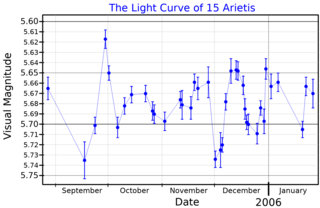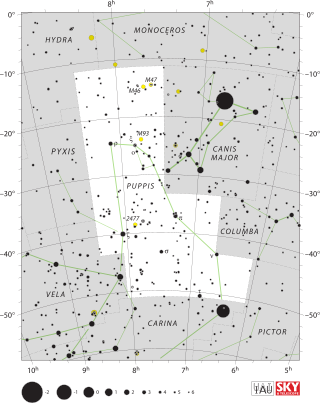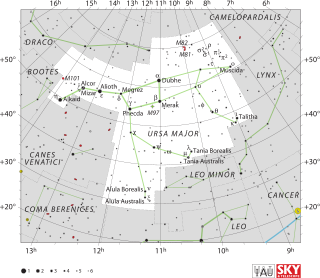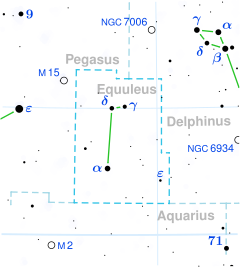
Iota Sagittarii is a star in the zodiac constellation of Sagittarius. With an apparent visual magnitude of +4.118, it is bright enough to be viewed with the naked eye. Based upon an annual parallax shift of 17.94 mas as seen from Earth, this star is located 182 light years from the Sun. It is moving away from the Earth with a radial velocity of +35.8 km/s.
65 Andromedae, abbreviated 65 And, is a single, orange-hued star in the northern constellation of Andromeda. With an apparent magnitude of 4.73, it is visible to the naked eye. The distance to 65 And can be derived from its annual parallax shift of 7.5 mas, which yields a range of around 440 light years. At that distance, its brightness is relatively lowered primarily by the inverse square law but also by an extinction of 0.16 magnitude due to interstellar dust. The star is moving closer to the Earth with a heliocentric radial velocity of −5 km/s.

15 Arietis is a single variable star in the northern constellation of Aries. 15 Arietis is the Flamsteed designation; it also bears the variable star designation AV Arietis. It has an apparent visual magnitude of 5.74, which is just bright enough to be visible to the naked eye from dark suburban skies. An annual parallax shift of 5.84 mas corresponds to a physical distance of approximately 560 light-years from Earth. At that distance, the star's brightness is reduced by 0.33 in magnitude because of extinction from interstellar gas and dust.
70 Aquilae, abbreviated 70 Aql, is a single orange-hued star in the equatorial constellation of Aquila. 70 Aquilae is its Flamsteed designation. It is visible to the naked eye with an apparent visual magnitude of 4.90. The distance to 70 Aquilae, as determined from its annual parallax shift of 3.5 mas, is around 940 light years. The star is moving closer to the Earth with a heliocentric radial velocity of −9 km/s.
66 Aquilae, abbreviated 66 Aql, is a fifth-magnitude star in the constellation of Aquila. 66 Aquilae is its Flamsteed designation. It is visible to the naked eye, having an apparent visual magnitude of 5.44. The star shows an annual parallax shift of 4.4 mas, which provides a distance estimate of around 730 light years. It is moving closer to the Earth with a heliocentric radial velocity of −30 km/s. The motion of the star over time suggests some displacement, which may indicate it is a close binary system.

Psi7 Aurigae, Latinized from ψ7 Aurigae, is a star in the northern constellation of Auriga. It is a dim, naked eye star with an apparent visual magnitude of 5.02. Based upon Gaia Data Release 2 parallax values, it is approximately 330 light-years from Earth.

Tau Puppis, Latinized from τ Puppis, is a star in the southern constellation of Puppis, near the southern constellation boundary with Carina. It is visible to the naked with an apparent visual magnitude of +2.95 and is located at a distance of about 182 light-years from Earth. The variable radial velocity of this system was detected by H. D. Curtis and H. K. Palmer in 1908, based on observations made at the D. O. Mills Observatory. It is a spectroscopic binary star system, with the presence of the secondary component being revealed by the shifts of absorption lines in the spectrum resulting from the Doppler effect. The two components orbit each other with a period of 1,066.0 days and a low eccentricity of 0.090.

Sigma1 Ursae Majoris (σ1 UMa) is the Bayer designation for a solitary star in the northern circumpolar constellation of Ursa Major. With an apparent visual magnitude of 5.14 it is faintly visible to the naked eye on dark nights. Based upon an annual parallax shift of 6.26 mas, it is located roughly 520 light years from the Sun. At that distance, the visual magnitude of the star is diminished by an extinction factor of 0.06 due to interstellar dust.
HD 200661 is a solitary star in the equatorial constellation Equuleus. It has an apparent magnitude of 6.41, placing it near the max naked eye visibility. The star is situated at a distance of 430 light years but is approaching with a heliocentric radial velocity of −12.1 km/s.
Upsilon Draconis is a binary star system in the northern circumpolar constellation of Draco. It is faintly visible to the naked eye with an apparent visual magnitude of 4.83. Based upon an annual parallax shift of 9.48 mas as measured from Earth, it is located around 340 light years from the Sun. At that distance, the visual magnitude of the star is diminished by an extinction factor of 0.02 due to interstellar dust.
HD 10550 is a single star in the equatorial constellation of Cetus. It is a faint star but visible to the naked eye with an apparent visual magnitude of 4.98. Based upon an annual parallax shift of 2.9564 mas, it is located around 1,100 light years from the Sun. The star is moving closer with a heliocentric radial velocity of −33 km/s. It has a high peculiar velocity of 72.7+5.7
−4.3 km/s and may be a runaway star.
Iota Eridani is a solitary star in the constellation Eridanus. It is visible to the naked eye with an apparent magnitude of 4.11. With an annual parallax shift of 0.02165 arcseconds, it lies at an estimated distance of about 151 light years.
HD 81799 is a suspected astrometric binary star system in the equatorial constellation of Hydra. It is visible to the naked eye with an apparent visual magnitude of 4.69. The distance to this system, as determined from an annual parallax shift of 19.9 mas, is 164 light years. It is moving further away from the Earth with a heliocentric radial velocity of 29 km/s. The system has a relatively high rate of proper motion, traversing the celestial sphere at the rate of 233±19 mas/yr along a position angle of 136°.

Rho Orionis, Latinised from ρ Orionis, is the Bayer designation for an orange-hued binary star system in the equatorial constellation of Orion. It is visible to the naked eye with an apparent visual magnitude of +4.44. The star shows an annual parallax shift of 9.32 mas due to the orbital motion of the Earth, which provides a distance estimate of roughly 350 light-years from the Sun. It is moving away from the Sun with a radial velocity of +40.5 km/s. About 2.6 million years ago, Rho Orionis made its perihelion passage at a distance of around 10 light-years.

Delta Phoenicis, Latinized from δ Phoenicis, is a single, yellow-hued star in the southern constellation of Phoenix. With an apparent visual magnitude of 3.93, it is visible to the naked eye. Based upon an annual parallax shift of 22.95 mas as seen from Earth, it is located 142 light years from the Sun. The star is moving closer to the Sun with a radial velocity of −7 km/s.
16 Virginis is a single star in the zodiac constellation of Virgo, located about 308 light years from the Sun. It has the Bayer designation c Virginis; 16 Virginis is the Flamsteed designation. This object is visible to the naked eye as a faint, orange-hued star with an apparent visual magnitude of 4.96. This is an IAU radial velocity standard star; it is moving further from the Earth with a heliocentric radial velocity of +37 km/s. The star has a relatively high proper motion, traversing the celestial sphere at an angular rate of 0.301″ per year.
HD 89998 is a single star in the southern constellation of Vela. It is a faint star but visible to the naked eye with an apparent visual magnitude of 4.82. The distance to HD 89998, as determined from its annual parallax shift of 15.9 mas, is 205 light years. The star is moving further from the Earth with a heliocentric radial velocity of +21 km/s, having come within 140 ly some 1.552 million years ago.

Nu2 Coronae Borealis is a solitary, orange-hued star located in the northern constellation of Corona Borealis. It is faintly visible to the naked eye, having an apparent visual magnitude of +5.4. Based upon an annual parallax shift of 5.49 mas, it is located roughly 590 light years from the Sun. At that distance, the visual magnitude is diminished by an extinction of 0.1 due to interstellar dust.
7 Draconis, also named Tianyi, is a single star in the northern circumpolar constellation of Draco. It is visible to the naked eye as a faint orange-hued star with a stellar classification of 5.43. Based upon an annual parallax shift of 4.16 mas as seen from the Earth, the star is located approximately 780 light-years from the Sun.

HD 25274, also known as HR 1241, is a solitary star located in the northern circumpolar constellation Camelopardalis. It is faintly visible to the naked eye as a red hued point of light with an apparent magnitude of 5.86. Gaia DR3 parallax measurements imply a distance of 597 light-years and it is currently drifting closer with a heliocentric radial velocity of −48.23 km/s. At its current distance, HD 25274's brightness is diminished by three-tenths of a magnitude due to interstellar extinction and it has an absolute magnitude of −0.51.










